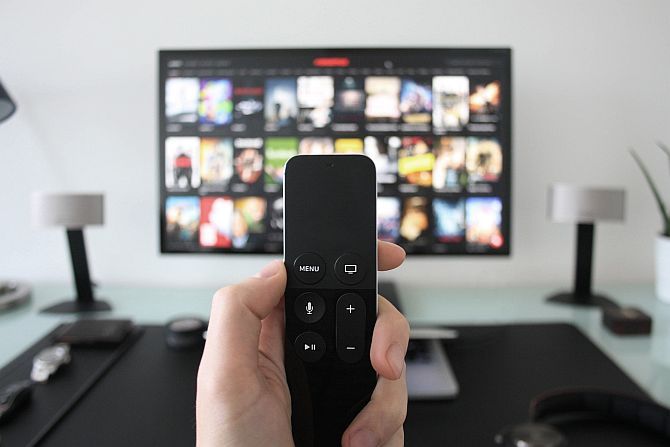For years it has been evident that fibre and DTH would give tough competition to cable in India where regulatory overload has mutilated an already warped industry structure. OTT added fuel to the fire.
From Rs 27,000 crore in 2010, cable’s share of subscription revenues is now estimated at Rs 13,000 crore.
Vanita Kohli-Khandekar reports.

Vishal Vijayrao Khodke is unhappy.
The 38-year-old owner of RCN Digital in Amravati, Maharashtra, had 14,000 homes on his cable TV network in 2015.
That is when the region began digitising.
People who did not want to spend on set-top boxes dropped out, leaving him with 11,500 homes.
In 2019 came the New Tariff Order that complicated channel choices and increased prices, pushing him down to 8,000 homes.
Khodke’s average revenue per user, or ARPU, from cable is now Rs 118 a month, down from Rs 150.
He has had to reduce his staff from 130 to 60.
“Broadcasters repackage popular programming from pay channels into free-to-air ones and put them on DD Freedish (the state-owned free DTH service).
"Why would a customer pay Rs 250 a month for cable?
He has a lot of alternatives — OTT (over-the-top), mobile, Freedish,” says Khodke.
The pandemic brought some good news: growth in television viewership and a rise in homes seeking cable internet.
Khodke now has 450 homes that use the cable to get Google, MX Player etc and pay upwards of Rs 400 per month for it.
Khodke’s story is one of India’s once-thriving cable TV business.
“Cable is dying,” says Jagjit Kohli, CEO of Digicable.
He was among the thousands of young men who slung the first few wires across Mumbai in the mid-eighties to create the world’s second largest television market by TV homes after China.
Star, Zee, Sony and Sun were among the hundreds of broadcasters that fuelled TV’s growth along with cable for almost three decades.
Now, “cable as a standalone video service is on a structural decline,” says Mihir Shah, vice president, Media Partners Asia.
For years it has been evident that fibre and DTH would give tough competition to cable in India where regulatory overload has mutilated an already warped industry structure.
OTT added fuel to the fire.
Cable’s survival lay in it becoming a provider of broadband internet.
This also pushes up ARPU by two times or more, reckons Manoj Madhavan, editor, Satellite & Cable TV Magazine.
The $104-billion Comcast, a cable company, is one of the largest broadband providers in the US.
It is on a Comcast connection that a majority of Americans watch Netflix or Amazon Prime Video, among other apps.
In India, Akshaya Diginet in Chennai and Seven Star in Mumbai are among the healthier multi-system operators (MSOs).
They are profitable and growing because a rising proportion of their homes now buy internet-enabled cable.
These are but local, standalone exceptions.
The number of cable homes with broadband is estimated at 21 million; that is about 80-90 million people.
This is split among dozens of small MSOs.
In a market with 750 million broadband consumers, not a single cable company is an internet provider on a national scale.
It all begins and ends with last-mile access, says Shah.
MSOs reach over 95 per cent of homes through local cable operators like Khodke.
The strength of the 155,000-plus cable operators lies in their access to consumer homes.
But many of them have barely 1,000 homes.
For decades their business model depended on negotiating with broadcasters and MSOs.
If an operator had 1,000 homes, he would pay for, say, 500 one year.
The number would increase every year based on negotiation.
What he paid had little to do with how many homes he reached or what channels were watched.
Everyone was guilty of perpetuating a structural defect — the lack of an addressable, transparent last mile.
This, now, has come to bite the business.
A large part of the blame lies with broadcasters who kept insisting on a minimum guarantee or fixed fee instead of pushing for actual numbers.
“Broadcasters just wanted subscription revenue growth every year; they didn’t care whether there was Covid or digitisation,” says Kohli.
MSOs were happy to go with the flow as long as they did not have to invest and got a share of revenues.
Local operators made their money from the taxes they saved by under-declaring their actual reach.
“Everybody just looked at how much they could take out of the business; nobody really invested in it,” says Tony D’Silva, former head of Sun’s DTH business and also head of Star’s distribution for many years.
The Telecom Regulatory Authority of India (TRAI) added to this by introducing price-control, on what is clearly not an essential commodity, early on in 2004.
This further incentivised the whole “let me get my share mentality”.
Digitisation, mandated in 2011, forced some transparency, but in larger cities.
In small towns and rural India, either people fell off the cable grid or millions of boxes lay inactive.
Neither the MSO nor the operator had the wherewithal to service these with software and call centres.
Then came the New Tariff Order in 2019.
“Until 2018, commercial arrangements between most MSOs and LCOs (local cable operators) were on a post-paid and fixed-fee basis.
"With the tariff order, the entire value chain shifted to a pre-paid system,” says Shah.
The pain of collecting money in advance from subscribers and sharing with MSOs and broadcasters meant you couldn’t hide people falling off the grid easily.
DTH did not lose too many consumers because it runs on a prepaid, digital, set-top box and call centre-enabled model.
In all, DTH operators have spent close to Rs 13,000 crore or so on capex. Most started making money only in the seventh year of operation.
“With the New Tariff Order, customers are paying more but margins for operators have dropped to the point where they are not making anything worthwhile.
"Many want to sell, but who’s investing,” says cable business veteran Rohinton Dadyburjor.
The lack of clarity on who owns a home — the MSO or local operator — meant that nobody wanted to invest in cable.
It also explains why no foreign investor has entered the sector though 100 per cent ownership is allowed.
The ones who ventured into internet access were stopped in their tracks by a 2010 Supreme Court ruling on licence fees.
“If a company made 90 per cent from cable TV and 10 per cent from the internet, it had to pay 8 per cent on the total,” says Vynsley Fernandes, CEO, NXT Digital.
This deterred investment.
In October 2021, this was changed via a notification.
Fernandes reckons it could help ease the way for foreign investment.
“Five years from now cable will metamorphosise. Its biggest advantage is that it has wire into homes,” he says.
The question is: who owns this wire?
Broadcast Audience Research Council data shows TV homes rose from 183 mn in 2016 to over 210 mn in 2020, pushing up the TV business from Rs 59,400 crore to Rs 68,500 crore.
Much of this rise has, however, gone to other distribution technologies (DTH, DD Freedish or to broadband providers such as Airtel and Jio).
The number of cable homes fell from 115 mn to under 100 mn; analysts put the figure closer to 70 mn.
From Rs 27,000 crore in 2010, cable’s share of subscription revenues is now estimated at Rs 13,000 crore.











